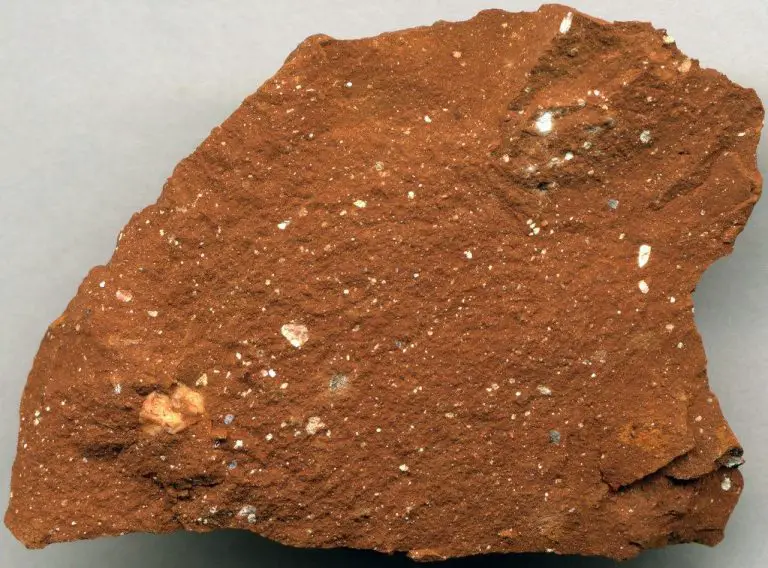What Causes Black Clay?
Black clay, also known as black dirt or black earth, refers to soil that contains a high percentage of organic matter and has a very dark color, usually black, dark brown or dark gray. There are several factors that can cause clay soils to become black in color.
The dark color of black clay is primarily caused by the presence of organic matter, which gives the soil a dark blackish or brownish hue. Organic matter contains pigmented humic substances that stain the soil dark colors. In addition, chemical processes involving iron, manganese, and sulfur compounds can lead to very dark or black soil colors.
In this article, we will examine the main causes of black clay soils and what contributes to their characteristic dark color.
Iron Oxide
Iron oxide, also known as iron rust, is one of the most common causes of black clay. When iron in the soil oxidizes, it forms iron oxide, which has a distinctive red or yellowish color. However, in some conditions, iron oxide can transform into black iron oxide, which gives clay a dark blackish hue.
This process often occurs in wet environments, where iron oxide particles aggregate into larger molecules. Under low oxygen conditions, these molecules shift to a black ferrous form rather than the more common ferric red form. Organic acids from plant decay can also encourage this reaction.
Clay’s small particle size and porous nature make it particularly prone to picking up black iron oxide molecules. As water flows through clay, it deposits the black iron particles within the clay’s structure, dyeing the clay an overall dark blackish color.
Areas with a lot of precipitation and iron-rich soils, like river valleys and deltas, tend to be most susceptible to black clay formation through iron oxide. However, any region with the right soil chemistry and moisture levels can develop black clay in this manner.
Organic Matter
Another culprit behind black clay soils is organic matter from decayed plant material. As plant matter decomposes over time, it releases dark-colored organic compounds like humic and fulvic acids. These substances bind to clay particles and leach into the soil, giving it a darker color. Areas with more vegetation and a history of plant decomposition tend to develop blacker soils due to the buildup of these organic compounds.
Wetland environments in particular foster plant decay and the accumulation of organic matter. Saturated conditions prevent complete decomposition, allowing partially broken down plant material to accumulate. The dark, waterlogged environment helps create black soils rich in organic matter. As a result, black clays are common in low, swampy areas where plant matter has decayed over long periods.
In general, wherever there are ample vegetation and humid conditions that promote decay, the resulting soil will have darker colors. The organic acids not only dye the soil black, they also influence the chemical and physical properties of the soil. A high organic content can make clay soils more aggregated and fertile. So the abundance of decomposed plant material not only causes the darkness, but improves the quality of black soils.
Manganese Oxides
Manganese oxides are another key contributor to the formation of black clay soils. Manganese is a naturally occurring mineral that is present in rocks and soil. When exposed to water and oxygen, manganese oxidizes and forms black manganese oxide compounds.
These manganese oxide compounds bind strongly to clay particles in the soil. As they accumulate over time, they cause the soil to turn black in color. Manganese oxides have a very fine particle size, allowing them to coat individual clay particles and create an overall blackish tone.
Areas with frequent wetting and drying cycles tend to promote manganese oxidation. Waterlogged soils can become depleted in oxygen, causing soluble manganese to convert to insoluble black manganese oxides upon exposure to air. These wet-dry cycles result in black streaking patterns in the soil.
In addition, acidic soils are more conducive to manganese oxide formation. Low pH causes more manganese to be freed from minerals into forms that can oxidize. The abundance of manganese oxides in acidic, seasonally saturated soils is a key reason why many black clay soils are found in such conditions.
Sulfides
Iron sulfides, especially pyrite, are a major cause of black clay formation. When iron sulfide minerals are present in soils and exposed to air and water, they break down in a process called oxidation. This releases acidity and dissolved iron into the soil, turning it black in color.
Specifically, pyrite (FeS2) oxidizes to form iron oxides and sulfuric acid (H2SO4) when exposed to oxygen and moisture. The acid dissolves surrounding clay minerals, releasing iron, aluminum and other metals. These metals then combine with the sulfuric acid to form black iron sulfates and other dark salts, staining the soil black.
Organic matter enhances pyrite oxidation by providing an energy source for iron-oxidizing bacteria like Thiobacillus ferrooxidans. These bacteria accelerate the oxidation process. Areas with large pyrite deposits, like coal fields, are especially prone to development of acidic, black clay soils due to rapid pyrite oxidation.
Fire
Burning organic material in clay soil can create black clay under certain conditions. As vegetation and organic matter burn, some of the carbon is reduced to elemental carbon in the form of soot or charcoal. This carbon can then mix with the clay soil at high temperatures, resulting in darker soil colors.
Fires that burn hot and long enough can create the conditions to change lighter clay into black clay. As fires spread across landscapes, temperatures often exceed 500°C on the soil surface. At these high temperatures, organic carbon is driven off the original plant material and transformed into more thermally stable carbon forms.
The carbon becomes mobile and can permeate into the clay minerals. With sufficient heat over time, this causes chemically reducing conditions that facilitate the carbon binding to the clay. The carbon essentially gets cooked into the crystalline structure of the clay minerals at the molecular level, darkening the soil color.
However, vegetation and soil moisture play a big role. In wetter soils and areas with sparse vegetation, fires may not burn hot enough or spread sufficiently to create widespread blackening of clay soils. Drier conditions with ample fuel sources promote fires that can generate black clay over bigger areas through this process.
Climate
The climate of a region plays an important role in determining the color of its clay. In humid, wet climates where rainfall is abundant, clays tend to develop darker colors over time. The ample moisture promotes chemical weathering and leaching of minerals in the clay that can darken its color.
In contrast, clay in drier climates with less rainfall tends to maintain lighter colors. With less moisture available, there is less chemical weathering and leaching of the clay minerals. Additionally, iron oxides which darken clay often get washed away in wetter climates, while they remain intact in drier areas.
Arid desert climates with very little rainfall produce distinctive red and orange clay soils. Without moisture, iron oxides are not washed away and they accumulate to stain the clay these signature hues. Meanwhile, tropical climates with heavy rainfall leach iron from clay, leading to white or gray kaolin clays.
Therefore, regional climate patterns clearly influence clay coloration. Abundant moisture and rainfall tends to produce darker clays through increased weathering and leaching. Drier conditions lead to accumulation of iron oxides that redden and orange clays. Climate is a key determiner of clay color.
Location
The location of soil plays a major role in determining the color of clay found within it. The climate, vegetation, landscape, geology, and water drainage patterns can vary significantly based on geographic location. Different locations experience different environmental conditions that impact the chemical, biological and physical weathering processes that lead to clay formation.
For example, soils in tropical climates are more prone to weathering compared to colder climates. The hot and humid conditions promote more rapid chemical weathering which releases iron, aluminum and organic matter that influence clay color. Tropical locations also support dense vegetation growth, so soils tend to contain higher levels of decaying plant matter. Meanwhile, soils in arid or desert climates experience minimal weathering and leaching. These locations may contain reddish clay since iron oxides are not flushed out by rainfall.
The mineralogy of the parent material is another location-dependent factor. Soils formed from iron-rich rock types will likely yield reddish or black clays. Drainage patterns related to the landscape relief also differ by location, impacting the extent of gleying and gleization which can create grey, greenish or bluish clay.
In summary, the regional variables present in different geographic locations have a major effect on clay color. The climate, vegetation, geology, and landforms create distinct weathering and soil formation conditions that influence the composition and colors of clay minerals present.
Other Factors
Here are some other minor factors that can contribute to the formation of black clay:
-
Plant decomposition can add organic matter, which gives clay a darker color.
-
Clays formed in locations with cooler climates tend to be darker due to limited leaching.
-
Over time, clay particles themselves may darken as they are exposed to sunlight and heat.
-
The mineralogy of the parent material affects the color of the resulting clay. Certain minerals like biotite mica can add darker colors.
While these factors play a lesser role, they can still influence the final color of clay in some environments.
Conclusion
Black clay soils derive their dark color from several key factors. The main causes are the presence of iron oxides, organic matter, and manganese oxides. These compounds bind to clay particles and coat them black. Fire and sulfides can also create black clays under certain conditions. The climate and location play a role as well, with wet, warm areas promoting the development of black clays. Overall, it is the unique combination and interaction of these chemical, biological, and environmental influences that lead to the formation of black clay soils across the globe.




